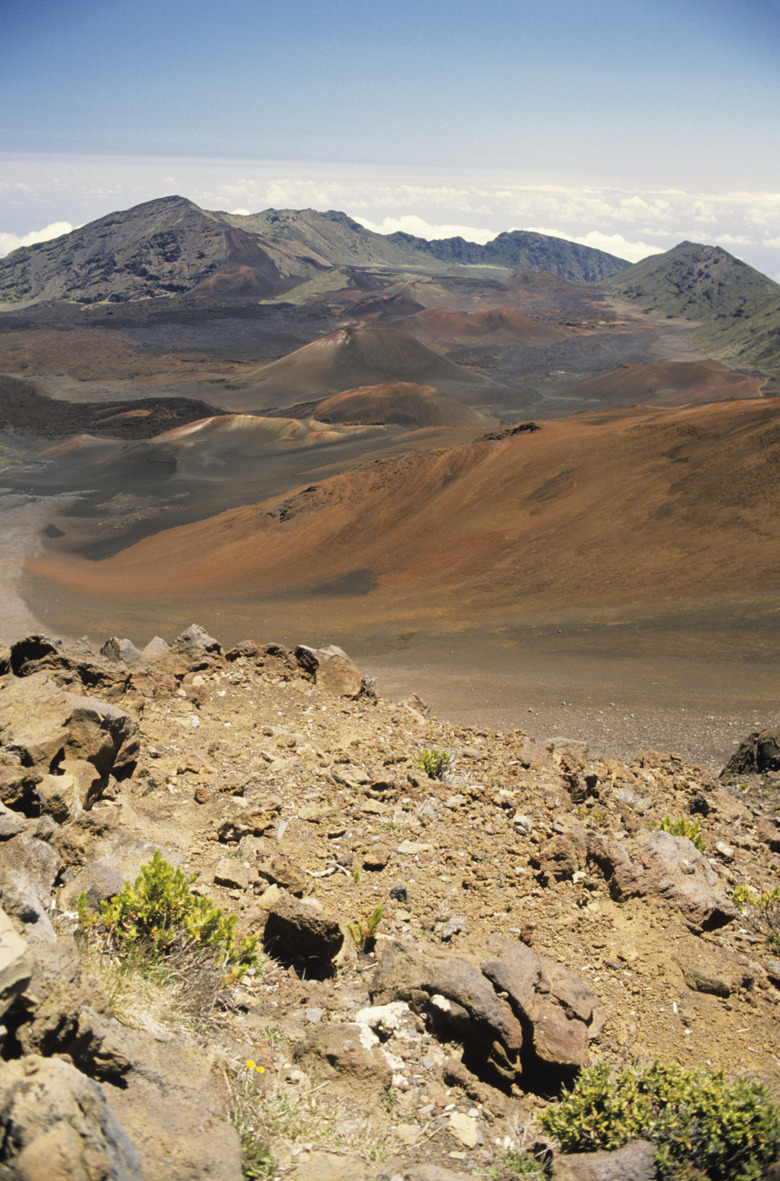What Are The Types Of Volcanic Activity That Do Not Involve The Eruption Of Lava?
There are many different volcanoes located all over the world, and all of them are unique. The don't erupt in the same way, and most won't erupt the same way twice. It all comes down to magma, the hot rock underground that powers volcanic activity. Most magmas contain the same ingredients, but not in the same amounts. Some magmas are runny and super hot, and contain very small amounts of gas, which produce quiet eruptions with lots of lava, like the Hawaiian eruptions. Others are thick, cooler and sticky, and these produce explosive eruptions like that of Mt. St. Helens.
Explosive Eruptions
Explosive Eruptions
Explosive eruptions happen where the magma inside the volcano has a high gas content and high viscosity — that is, its thick and sticky. Underground, where the magma is under pressure, gases are dissolved into the magma, but as it gets closer to the surface the gasses come out of solution. Because the magma is so thick, it holds together for long periods of time, and takes a great deal of pressure to break, so when it does, it explodes, creating ash, rock and super heated gas. Typically, the more explosive the eruption, the less lava will be attached to it.
Phreatic and Phreatomagmatic Eruptions
Phreatic and Phreatomagmatic Eruptions
These two eruption types are considered violently explosive. Phreatic or steam-blast eruptions happen when magma encounters shallow groundwater. When this happens, the water is instantly turned to steam in a reaction known as "flashing." The steam explodes from the ground, shattering the rock surrounding it and throwing those rocks around, but none of the magma gets out. In a phreatomagmatic eruption, the same thing happens, but some of the magma is shot out as well in the form of ash, which creates a plume. No lava is produced by either, but they will usually result in a new volcano.
Plinian Eruptions
Plinian Eruptions
Plinean eruptions are another of the violently explosive type. They are not caused by groundwater, but by the gasses already dissolved in the magma. Some of the most famous eruptions in history have been plinean. Volcanoes prone to this type of eruption are Vesuvius, Krakatau, and Mt. St. Helens. Plinean eruptions produce large quantities of ash, rock and gas, sometimes over long periods of time, and ash from these eruptions can be spread all over the world. Tall ash clouds can produce pyroclastic flows. These are super-heated ash and gases that rush down the mountain incinerating everything in their path and cover the area with layers of rock and ash. Lava flow is minimal if present at all.
Pellean Eruptions
Pellean Eruptions
The last of the violent eruption types is the Pellean eruption. This happens when a lava dome — a pile-up of lava so sticky that it can't run — piles up around the volcano's vent and collapses. When this happens, it rains hot, glowing ash and rock down the sides of the volcano in a type of pyroclastic flow called a block-and-ash flow. This is powerful enough to topple walls and start fires, but it doesn't have the obliterating power of a Plinean pyroclastic flow, and its range is limited. There may be several of these events over time before activity at the volcano stops.
Cite This Article
MLA
Dolph, Mara. "What Are The Types Of Volcanic Activity That Do Not Involve The Eruption Of Lava?" sciencing.com, https://www.sciencing.com/types-volcanic-activity-not-involve-eruption-lava-12319343/. 24 April 2017.
APA
Dolph, Mara. (2017, April 24). What Are The Types Of Volcanic Activity That Do Not Involve The Eruption Of Lava?. sciencing.com. Retrieved from https://www.sciencing.com/types-volcanic-activity-not-involve-eruption-lava-12319343/
Chicago
Dolph, Mara. What Are The Types Of Volcanic Activity That Do Not Involve The Eruption Of Lava? last modified March 24, 2022. https://www.sciencing.com/types-volcanic-activity-not-involve-eruption-lava-12319343/
